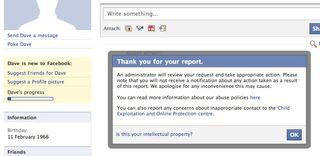Facebook enhances safety but still no 'panic button'
Facebook rolls out an ad campaign and integrates a CEOP link, but holds back from offering a 'safety button'.

Facebook has agreed to a host of new safety measures, but still refuses to install a so-called "panic button" on all pages.
The social networking site has come under fire over child safety, notably after teenager Ashleigh Hall was murdered after meeting Peter Chapman via the site, where he pretended to be a teenage boy.
Claiming its new tactics make up the largest ever UK online safety campaign, Facebook is to give 5 million in advertising - some billion page impressions - to boost safety awareness over the next two years, as well as create a 24-hour hotline to help police.
While it will also allow users to connect directly to the Child Exploitation and Online Protection Centre (CEOP) to report concerns, it will not add a button to that site on every page, saying it's looking to create a "safety net", not just offer a safety button.

"There is no single answer to making the internet or Facebook safer," said Elliot Schrage, vice president of global communications and public policy at Facebook. "That's why we're approaching this in so many different ways."
"We've redesigned Facebook's abuse reporting mechanisms," he added in a statement. "We're investing in raising awareness, and giving parents, educators and teens new tools. We're building new bridges with law enforcement and encouraging new laws and regulations."
Jim Gamble, the chief executive of CEOP, said his group would still like to see the button on Facebook.
Get the ITPro. daily newsletter
Receive our latest news, industry updates, featured resources and more. Sign up today to receive our FREE report on AI cyber crime & security - newly updated for 2024.
"What I am pleased about is there is a commitment from them to improve what they provide to UK policing," he told The Telegraph.
"Given that and the positive nature of it and their commitment to working much more closely with us, I still remain of the same view that the button is key," he said.
"I felt that at the end of what were lengthy and at times tense negotiation we are able to move towards a position. They are one small step away from doing the right thing."




